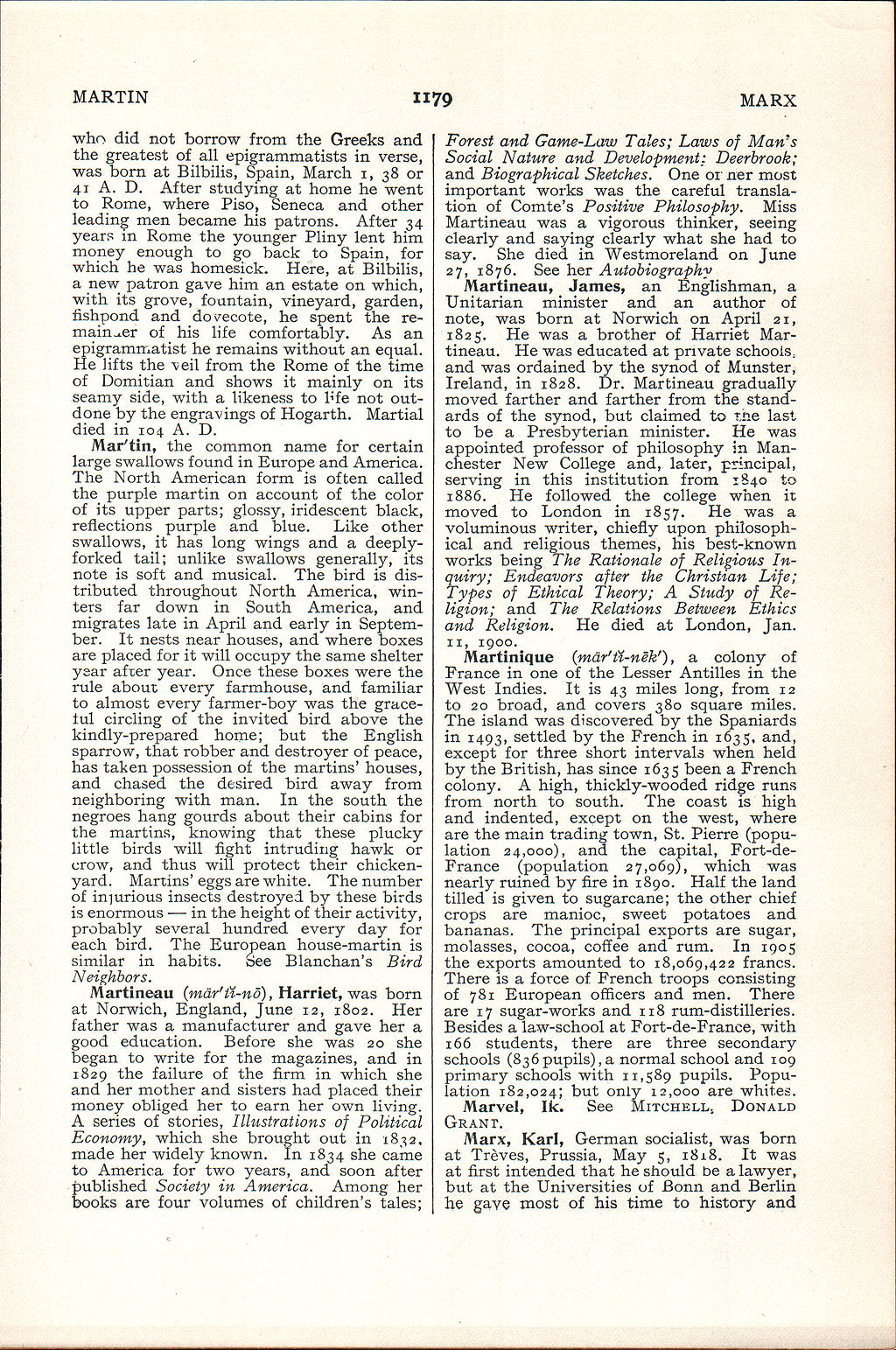Page 1179 : MARTIN — MARX
Individual articles:
who did not borrow from the Greeks and the greatest of all epigrammatists in verse, was born at Bilbilis, Spain, March 1, 38 or 41 A. D. After studying at home he went to Rome, where Piso, Seneca and other leading men became his patrons. After 34 years in Rome the [[../Pliny the Younger|younger Pliny]] lent him money enough to go back to Spain, for which he was homesick. Here, at Bilbilis, a new patron gave him an estate on which, with its grove, fountain, vineyard, garden, fishpond and dovecote, he spent the remainder of his life comfortably. As an epigrammatist he remains without an equal. He lifts the veil from the Rome of the time of [[../Domitian, Titus Flavius Domitianus|Domitian]] and shows it mainly on its seamy side, with a likeness to life not outdone by the engravings of [[../Hogarth, William|Hogarth]]. Martial died in 104 A. D.
Mar′tin, the common name for certain large [[../Swallows|swallows]] found in Europe and America. The North American form is often called the purple martin on account of the color of its upper parts; glossy, iridescent black, reflections purple and blue. Like other swallows, it has long wings and a deeply-forked tail; unlike swallows generally, its note is soft and musical. The bird is distributed throughout North America, winters far down in South America, and migrates late in April and early in September. It nests near houses, and where boxes are placed for it will occupy the same shelter year after year. Once these boxes were the rule about every farmhouse, and familiar to almost every farmer-boy was the graceful circling of the invited bird above the kindly-prepared home; but the English [[../Sparrow|sparrow]], that robber and destroyer of peace, has taken possession of the martins’ houses, and chased the desired bird away from neighboring with man. In the south the [[../Negroes|negroes]] hang [[../Gourd|gourds]] about their cabins for the martins, knowing that these plucky little birds will fight intruding [[../Hawk|hawk]] or [[../Crow|crow]], and thus will protect their chicken-yard. Martins’ eggs are white. The number of injurious [[../Insects|insects]] destroyed by these birds is enormous — in the height of their activity, probably several hundred every day for each bird. The European house-martin is similar in habits. See Blanchan’s Bird Neighbors.
'Martineau (mär′ tĭ-nō), Harriet, was born at Norwich, England, June 12, 1802. Her father was a manufacturer and gave her a good education. Before she was 20 she began to write for the magazines, and in 1829 the failure of the firm in which she and her mother and sisters had placed their money obliged her to earn her own living. A series of stories, Illustrations of Political Economy, which she brought out in 1832, made her widely known. In 1834 she came to America for two years, and soon after published Society in America. Among her books are four volumes of children’s tales; Forest and Game-Law Tales; Laws of Man’s Social Nature and Development; Deerbrook; and Biographical Sketches. One or her most important works was the careful translation of Comte’s Positive Philosophy. Miss Martineau was a vigorous thinker, seeing clearly and saying clearly what she had to say. She died in Westmoreland on June 27, 1876. See her Autobiography.
Martineau, James, an Englishman, a Unitarian minister and an author of note, was born at Norwich on April 21, 1825. He was a brother of [[../Martineau, Harriet|Harriet Martineau]]. He was educated at private schools, and was ordained by the synod of Munster, Ireland, in 1828. Dr. Martineau gradually moved farther and farther from the standards of the synod, but claimed to the last to be a Presbyterian minister. He was appointed professor of [[../Philosophy|philosophy]] in Manchester New College and, later, principal, serving in this institution from 1840 to 1886. He followed the college when it moved to London in 1857. He was a voluminous writer, chiefly upon philosophical and religious themes, his best-known works being The Rationale of Religious Inquiry; Endeavors after the Christian Life; Types of Ethical Theory; A Study of Religion; and The Relations Between Ethics and Religion. He died at London, Jan. 11, 1900.
Martinique (mär′ tĭ-nēk′), a colony of France in one of the Lesser Antilles in the West Indies. It is 43 miles long, from 12 to 20 broad, and covers 380 square miles. The island was discovered by the Spaniards in 1493, settled by the French in 1635, and, except for three short intervals when held by the British, has since 1635 been a French colony. A high, thickly-wooded ridge runs from north to south. The coast is high and indented, except on the west, where are the main trading town, St. Pierre (population 24,000), and the capital, Fort-de-France (population 27,069), which was nearly ruined by fire in 1890. Half the land tilled is given to sugarcane; the other chief crops are [[../Cassava|manioc]], [[../Sweet Potato|sweet potatoes]] and [[../Banana|bananas]]. The principal exports are [[../Sugar|sugar]], molasses, [[../Cocoa|cocoa]], [[../Coffee|coffee]] and [[../Rum|rum]]. In 1905 the exports amounted to 18,069,422 francs. There is a force of French troops consisting of 781 European officers and men. There are 17 sugar-works and 118 rum-distilleries. Besides a law-school at Fort-de-France, with 166 students, there are three secondary schools (836 pupils),a normal school and 109 primary schools with 11,589 pupils. Population 182,024; but only 12,000 are whites.
Marvel, Ik. See Mitchell, Donald Grant.
Marx, Karl, German socialist, was born at Trèves, Prussia, May 5, 1818. It was at first intended that he should be a lawyer, but at the Universities of Bonn and Berlin he gave most of his time to history and
